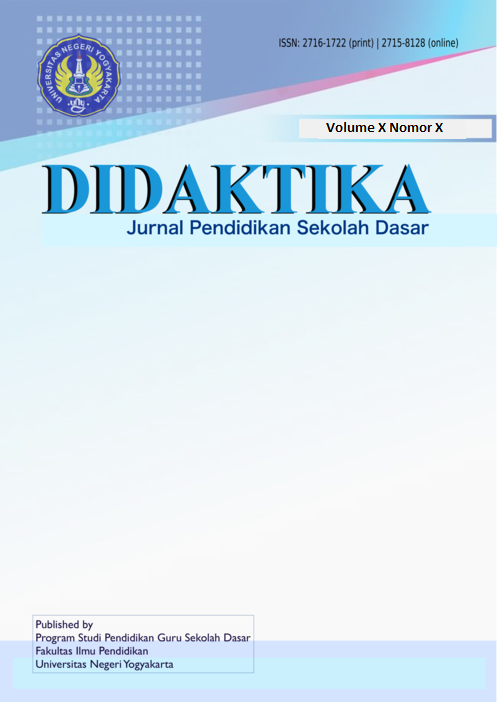Keefektifan Model Problem Based Learning Berbantu Media Audio-Visual Terhadap Peningkatan Kemampuan Penalaran Siswa
DOI:
https://doi.org/10.21831/didaktika.v4i2.42083Abstract
The purpose of this research is to find out how the Effectiveness of Problem Based Learning Learning Model on Improving the Reasoning Ability of Class II Students in terms of fractional materials assisted by audio-visual media. The research design used in this study was the One Group Pretest Posttest Design. From the pretest value the average value of the class is 57.88 while the posttest value is 86.83, and based on the t-test analysis obtained tcount (34.449) t table (2.062) so H0 is rejected, meaning that the average before and after being treated is not same. Also shown in the classical mastery test, the results of the pretest reached 27% classical learning completeness. The results of the posttest achieved a learning completeness of 88%. A class is said to be complete if there are 67% of students who have completed learning. Thus, the posttest results can be said to be classically complete with 88% of students completing learning. It can be concluded that the Problem Based Learning learning model assisted by Audio-Visual Media is effective in increasing the reasoning abilities of second grade students at SD Negeri Pleburan 02 Semarang.
References
Fathurrohman, M. (2017). Model-Model Pembelajaran Inovatif. Jogjakarta: Ar-Ruzz Media.
Jannah, A., Rahmawati, I., & Reffiane, F. (2020). Keefektifan Model PBL Berbantu Media Audio-Visual Terhadap Hasil Belajar Tema Indahnya Keberagaman Di Negeriku. MIMBAR PGSD Undiksha, 8(3), 342-350. http://dx.doi.org/10.23887/jjpgsd.v8i3.28951
Pane, A., & Dasopang, M. D. (2017). Belajar dan pembelajaran. Fitrah: Jurnal Kajian Ilmu-Ilmu Keislaman, 3(2), 333-352.
Purnomo, Y. W., Arlini, R., Nuriadin, I., & Aziz, T. A. (2021). Learning trajectory based on fractional sub-constructs: Using fractions as quotients to introduce fractions. Mathematics Teaching-Research Journal, 13(3), 183–207. https://commons.hostos.cuny.edu/mtrj/wp-content/uploads/sites/30/2021/10/v13n3-Learning-trajectory-based-on-fractional-sub-constructs.pdf
Purnomo, Y. W., Widowati, C., & Ulfah, S. (2019). Incomprehension of the Indonesian Elementary School Students on Fraction Division Problem. Infinity Journal, 8(1), 57–74. https://doi.org/10.22460/infinity.v8i1.p57-74
Safitri, F. N., Reffiane, F., & Subekti, E. E. (2020). Model Problem Based Learning (PBL) Berbasis Etnomatematika pada Materi Geometri Terhadap Hasil Belajar. MIMBAR PGSD Undiksha, 8(3), 492-498.
Simatupang, R., & Surya, E. (2017). Pengaruh Problem Based Learning (PBL) terhadap kemampuan penalaran matematis siswa. Jurnal Pendidikan Matematika.
Sugiyono. (2017). Metode Penelitian Kuantitatif, Kualitatif, dan R&D. Bandung: Alfabeta.
Umam, Muhammad Dliwaul. (2014). Analisis kesalahan siswa dalam menyelesaikan soal cerita matematika materi operasi hitung pecahan. MATHEdunesa, 3(3).
Vera, K., & Wardani, K. W. (2018). Peningkatan keterampilan berfikir kritis melalui model problem based learning berbantuan audio visual pada siswa kelas IV SD. Jurnal Riset Teknologi dan Inovasi Pendidikan (JARTIKA), 1(2), 33-45.
Wahyuningrum, R. (2012). Peningkatan Pemahaman Konsep Dalam Menyelesaikan Soal Cerita Matematika Melalui Pendekatan Open-Ended Pada Siswa Kelas V SDN 02 Ngargoyoso Karanganyar Tahun Pelajaran 2011/2012 (Doctoral dissertation, Universitas Muhammadiyah Surakarta.
Downloads
Published
How to Cite
Issue
Section
Citation Check
License
- Authors retain copyright and grant the journal right of first publication with the work simultaneously licensed under a Creative Commons Attribution License that allows others to share the work with an acknowledgement of the work's authorship and initial publication in this journal.
- Authors are able to enter into separate, additional contractual arrangements for the non-exclusive distribution of the journal's published version of the work (e.g., post it to an institutional repository or publish it in a book), with an acknowledgement of its initial publication in this journal.
- Authors are permitted and encouraged to post their work online (e.g., in institutional repositories or on their website) prior to and during the submission process, as it can lead to productive exchanges, as well as earlier and greater citation of published work.






